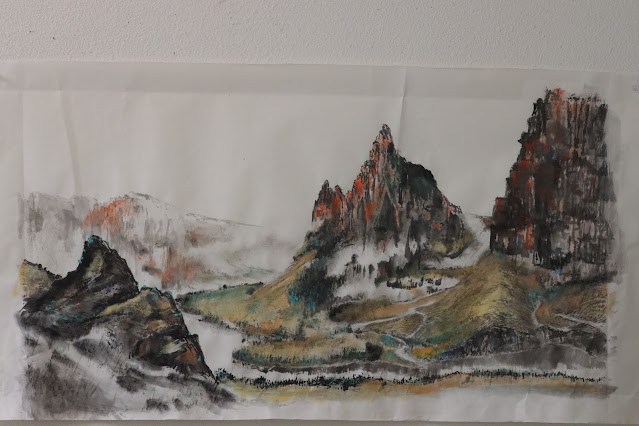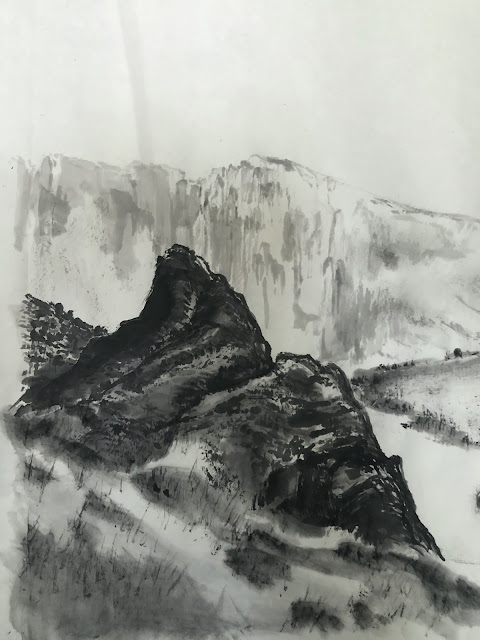We've had a string of days that are warmer than usual. It is the succession of days of 90 plus degrees that tires a person, especially when that person has to rely on natural convection cooling. The fan does help to move the air and create some evaporative cooling from the moist skin, so it helps somewhat, psychologically at least.
When the rainy season stopped the pond behind my house ceased to enjoy the flow it normally gets from the creek that feeds it. The water level has dropped a couple of feet behind the weir and the pond has become stagnant, overgrown with algae. The homeowner's association has spent good money seeking supposedly professional advice, planting shrubs and tall grass next to the bank to ostensibly lower the water temperature and therefore slow down algae growth. To no avail.... I could have told them that. Then some homeowners do not like the raggedy look of the plants and trimmed them down, as if they are ornamental hedges. One homeowner even resorted to putting algaecide into the water, which is a violation of environmental protection laws. It is a contentious issue, to say the least.
For lack of better ways to spend a hot day, I've been looking at this body of pea soup through my blinds. There are still ducks around, lazily paddling their feet in the summer heat, feeding occasionally under the water. They carve out channels amongst the algae, like an icebreaker creating passages through the artic ice. I suppose I am visualizing ice subconsciously to squelch this suffocating heat.
Now these patches of algae are forming an interesting floating mosaic. They look more yellowish than green. The sun still glimmers off the water in dancing flashes despite the lack of any perceptible wind. The thickness of the day is breached only by the ducks quacking. This looks like painting material.
I am looking at this as a challenge to myself, like every painting that I've attempted. I am going to attempt to put that suffocating feeling onto paper and I am going to try something new in the process.
Normally Xuan paper is not conducive to heavy staining or repeat brushstrokes. Chinese brush painting hinges on the artist making the right brushstroke the first time. Whatever comes out of the brush is indelible and seals the fate. What I am internalizing is not something that is airy or elegant. It is musty and dense and confused. I have to attempt to lay down as many brushstrokes as possible without wearing down a hole in the paper. I am not going to adhere to the usual Chinese Brush preferences. I decide to use the gold speckled Xuan that was gifted to me. This paper is more substantial than the standard Xuan.
The random gold speckles elicit the feeling of the shimmering surface of the pond. I hope to enhance the appearance of patches of reflected surface with the help of alum solution. Alum as you recall is used for sizing Xuan paper. It makes the paper less absorbent. I use a spray bottle to spray some saturated alum solution on the paper and allow that to dry. The hope is that these droplets will block subsequent coloration and give off a painted surface with random voids in it.
AS long as I am experimenting why don't I mix the blue color into my saturated alum solution. Hopefully the spray will help form the foundation of the water.
I do the same with the green color, for my algae.
There is only one way to find out if my theory works or not, and that is by doing it and let the result speak for itself. One can see clear borders around the droplets, especially the small ones. The large drops are overwhelming their neighbors and obfuscate the clear border. So I am on the right track.
The droplets of alum solution can be traced to all the round void spaces. I think they are nicely juxtaposed with the rest of the brushstrokes, showing off the reflected sky and the algae in the water. The gold speckles are not obvious at all in the photography but they are more noticeable in person. One has to view the painting at a certain angle to see the sparkle.
Dense and garbled. The way I saw it.

















































